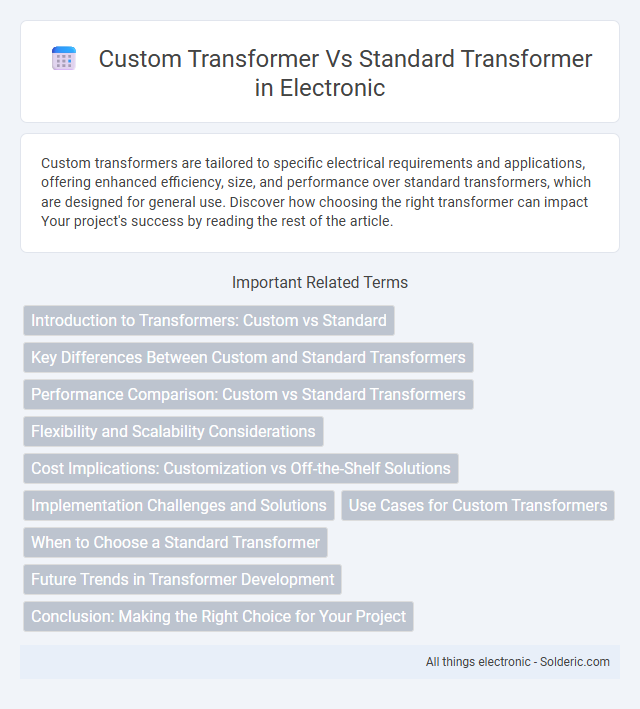Custom transformers are tailored to specific electrical requirements and applications, offering enhanced efficiency, size, and performance over standard transformers, which are designed for general use. Discover how choosing the right transformer can impact Your project's success by reading the rest of the article.
Comparison Table
| Feature | Custom Transformer | Standard Transformer |
|---|---|---|
| Design | Tailored architecture for specific tasks | General-purpose, widely used architecture |
| Flexibility | High customization for domain needs | Limited to predefined structure and parameters |
| Performance | Optimized for task-specific accuracy and speed | Balanced accuracy across various tasks |
| Complexity | May increase due to custom modules and layers | Standardized complexity, easier to implement |
| Training Data | Requires tailored datasets for fine-tuning | Pre-trained on large, diverse corpora |
| Use Cases | Specialized applications like medical, legal, or industrial NLP | Broad applications across NLP tasks |
| Development Time | Longer due to custom design and testing | Faster deployment leveraging existing models |
Introduction to Transformers: Custom vs Standard
Transformers are powerful deep learning models designed for handling sequential data, widely used in natural language processing and computer vision. Standard transformers follow a fixed architecture with pre-defined layers and self-attention mechanisms, offering strong baseline performance across various tasks. Custom transformers allow you to modify components such as attention heads, layer normalization, or positional encoding to tailor the model for specific applications or improve efficiency and accuracy.
Key Differences Between Custom and Standard Transformers
Custom transformers offer tailored voltage, current, and impedance specifications to meet precise application requirements, unlike standard transformers which provide fixed, mass-produced ratings. Custom transformers enable optimized electrical performance and design flexibility for unique industrial, medical, or aerospace applications. Standard transformers typically emphasize cost-effectiveness and availability for common distribution, power supply, and general-purpose uses.
Performance Comparison: Custom vs Standard Transformers
Custom transformers often outperform standard transformers by being tailored to specific tasks or datasets, resulting in enhanced accuracy and efficiency. Standard transformers provide a strong baseline with proven architectures but may lack optimization for niche applications, potentially leading to slower inference times and higher resource consumption. Your choice should weigh the trade-offs between customization benefits and the robustness of established models to maximize performance for your unique needs.
Flexibility and Scalability Considerations
Custom transformers offer enhanced flexibility by allowing tailored configurations to specific data types and use cases, enabling fine-tuned performance improvements over standard transformers. They support scalability through modular architectures that can be optimized for different hardware and deployment environments, addressing unique computational constraints. Standard transformers provide a robust baseline but often lack the adaptability required for domain-specific tasks or large-scale distributed training scenarios.
Cost Implications: Customization vs Off-the-Shelf Solutions
Custom transformers typically entail higher upfront costs due to tailored design, specialized materials, and unique specifications that meet specific operational requirements. Standard transformers benefit from economies of scale, resulting in lower initial prices and reduced lead times, although they may require additional modifications or compromises in efficiency for unique applications. Over the long term, custom transformers can offer cost savings through improved performance, energy efficiency, and reduced maintenance expenses, offsetting their initial investment in specialized environments.
Implementation Challenges and Solutions
Custom transformers often face implementation challenges such as integration complexity, requirement for specialized coding, and higher resource consumption compared to standard transformers. Overcoming these challenges involves adopting modular coding practices, leveraging pre-built libraries like Hugging Face Transformers, and optimizing computational efficiency through techniques like mixed precision training. Employing comprehensive testing frameworks and robust error handling further ensures reliable deployment and scalability of custom transformer models.
Use Cases for Custom Transformers
Custom transformers excel in specialized applications requiring tailored feature extraction, such as domain-specific language processing, medical data analysis, or financial time series forecasting. Unlike standard transformers, which provide general-purpose architectures, custom transformers enable you to incorporate unique embedding techniques, attention mechanisms, or positional encodings to better capture the nuances of your dataset. This customization enhances model performance and interpretability in cases where off-the-shelf transformers fall short.
When to Choose a Standard Transformer
Choose a standard transformer when dealing with common voltage conversion tasks in residential, commercial, or industrial applications where reliability, cost-effectiveness, and ease of replacement are priorities. Standard transformers provide proven performance with established design specifications, making them suitable for environments with stable load requirements and minimal need for customization. These transformers support efficient energy transfer in typical power distribution systems without the need for unique voltage ratios or specialized configurations.
Future Trends in Transformer Development
Future trends in transformer development emphasize enhanced efficiency and adaptability, with custom transformers tailored to specific applications outperforming standard models in energy savings and performance optimization. Innovations in materials, such as amorphous steel and nanocrystalline cores, are driving reduced losses and improved thermal management in bespoke designs. Integration of smart technologies and AI-driven diagnostics is also transforming custom transformers into proactive components for predictive maintenance and grid resilience.
Conclusion: Making the Right Choice for Your Project
Choosing between a custom transformer and a standard transformer depends on your project's specific requirements, including performance, scalability, and customization needs. Custom transformers offer tailored solutions that optimize model efficiency and accuracy but may require more development time and expertise. Standard transformers provide reliable, tested architectures that accelerate deployment and simplify integration while potentially limiting flexibility.
custom transformer vs standard transformer Infographic

 solderic.com
solderic.com